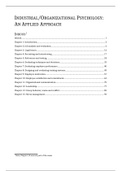INDUSTRIAL/ORGANIZATIONAL PSYCHOLOGY:
AN APPLIED APPROACH
INHOUD1
Inhoud................................................................................................................................................................................... 1
Chapter 1: Introduction.................................................................................................................................................. 2
Chapter 2: Job analysis and evaluation.................................................................................................................... 6
Chapter 3: Legal issues................................................................................................................................................. 12
Chapter 4: Recruiting and interviewing................................................................................................................ 17
Chapter 5: References and testing........................................................................................................................... 24
Chapter 6: Evaluating techniques and decisions............................................................................................... 33
Chapter 7: Evaluating employee performance................................................................................................... 40
Chapter 8: Designing and evaluating training systems................................................................................... 49
Chapter 9: Employee motivation............................................................................................................................. 57
Chapter 10: Employee satisfaction and commitment...................................................................................... 63
Chapter 11: Organizational communication........................................................................................................ 70
Chapter 12: Leadership................................................................................................................................................ 77
Chapter 13: Group behavior, teams and conflict............................................................................................... 85
Chapter 15: Stress management.............................................................................................................................. 93
1
Note, Chapter 14 was not part of the exam.
,Stella Barenholz
CHAPTER 1: INTRODUCTION
THE FIELD
Industrial/organizational psychology is a branch of psychology that applies the principles of
psychology to the workplace. The purpose of I/O psychology is “to enhance the dignity and
performance of human beings, and the organizations they work in, by advancing the science and
knowledge of human behavior”.
I/O psychology differentiates from HRM and business fields by looking at what the individuals
need. I/O psychology relies extensively on research, quantitative methods, and testing
techniques.
Work and organizational psychology consists of different terms around the world. WOP is used
in Europa; in the US, Industrial Organizational Psychology is used. In other regions, Industrial
psychology is used. We will use Work Psychology or Work and Organizational Psychology.
WOP has a very long and rich history with loads of developments. WOP started during their
work during the first WW, where they had the opportunity to assess what people needed. There
was a recruitment of soldiers to assess which job was perfect for them. The testing was
accomplished mainly through the Army Alpha (who could read) and Army Beta (who couldn’t
read) tests of mental ability. John Watson, Thomas Edison, and Frank Gilbreth and Lillian Moller
Gilbreth were some pioneers during that time.
After the 1930’s, the findings from the famous Hawthorne studies (represent any change in
behavior when people react to a change in the environment)were published, psychologists
became more involved in the quality of the work environment, as well as the attitudes of
employees. Here they saw the Hawthorne effect, when employees change their behavior due to
the fact that they are receiving attention or are being observed.
During the 1960’s the human rights were a common issue, in the 1970’s employee satisfaction
and motivation became interesting. Skinner here played accent on behavior-modification
techniques in organizations.
Later in the 80’s and 90’s there were some big changes: increased use of fairly sophisticated
statistical techniques and methods of analysis, application of cognitive psychology, effects of
work on family life and leisure activities, developing methods to select employees.
Since 2000 the major change is the advanced technology. There is also a big demographic
change, more women are taking over.
Psychology looks at affect, behavior and cognition, coming from attitude. The question is how
these three aspects interact in the context of work. How does what people think, what they do
and how they feel contributes to being active, sense of burnouts, identification, them having a
sense of belonging?
Essentially, you spend a third of your life working. It is difficult to find the perfect work, only
some people find this job. As an organization, you need to be productive. To do this, every
employee needs to have the perfect job. Organizational psychologists bring the positive side to
the workplace by trying to find the perfect job, or adjust the job to the individual and find a
consensus.
As organizational psychologists, you have to find common grounds. This starts off with a
research project, to understand what people need and are going through. In order to do that, you
need to ask them questions. The goal is to establish a culture in the organization where people
can identify with, to make them work the most effectively.
How would you define work psychology?
It is about individual effectiveness. Applying principles of psychology to the workplace. We look
at development of careers, literature of learning, personnel psychology. We want to understand
2
,Stella Barenholz
why someone chooses the work that they do. With the help of the social identity theory, we can
look at how someone identifies with the work and organization. We look at their engagements,
burnouts. We apply psychology to understand what an individual does in the context of work,
and what makes them tick.
The goal of WOP is to increase the productivity and well-being of employees.
- The industrial approach: determining the competencies needed to perform a job,
staffing the organization with employees with those competencies, and increasing those
competencies through training.
- The organizational approach: organizational structure and culture that will motivate
employees to perform well, give them the information to do their jobs, and provide
working conditions that are safe and result in an enjoyable and satisfying work/life
environment.
Fields of WP:
- Personnel psychology: selection, training and development of employees
- Organizational psychology: organizational development, changes, the behavior of
employees within the context of an organization (consultants)
- Human Factors/Ergonomics: whether or not the staff is supported, the interaction
between humans and machines
- Occupational Health: whether or not the staff feel safe, if they have enough time off
- Consumer psychology: part of economy, whether or not the product reaches the people
- Coaching psychology: personal development, promoting personal development
This all comes together in Modern WP. The key areas here: recruitment, selection, and
assessment (finding the right person for the right position); learning, training and development;
performance measurement and management; and careers and career management.
So the idea of WP is the application of psychological principles to understand how to apply it and
fill the gap between practice and science. We look at the problems that organizations and
individuals have to face with.
People that graduate in the field of WOP mostly go into the field of consultant. Psychologists who
work in the private and public sectors perform similar duties as consultants, but they do so in
very different environments.
There are different educational requirements and types of programs to find a job in the WOP
field. A way of assessing someone is by doing the Graduate Record Exam (GRE), a standardized
admission test required by most psychology graduate schools. Students can go for their Master’s
degree after bachelor. Most programs also allow the student to complete an internship or
practicum with a local organization. Besides getting a Master, doctoral programs to get a Ph.D.
are also possible. In addition to a thesis, a student working toward a Ph.D. must complete a
dissertation.
RESEARCH
Research: we ask questions about behaviors: why do people behave in certain aspects?
People here are scientist practitioners, the conduct research and apply these principles into an
organization. We conduct research to answer questions and make decisions, for research in
everyday life, and to prove that common sense is often wrong.
The first step in conducting research is to decide what to research. We start here by asking a
question we want to answer. This is called an idea, everything is based on an idea. Once a
question has been asked, the next step is to form a hypothesis: an educated prediction about the
answer to a question. This prediction is usually based on a theory: a systematic set of
assumptions regarding the cause and nature of behavior. At times, forming a hypothesis can be
difficult. In some cases, no previous research has been conducted or theory proposed that would
suggest a clear hypothesis about the answer to a question.
3
, Stella Barenholz
Once a research idea has been created, the next step is to search the literature for similar
research. When reviewing the literature, you are likely to encounter four types of periodicals:
journals (articles written by researchers directly reporting the results of a study), bridge
publications (written by professors about a topic of interest to practitioners), trade magazines
(written by professional writers who have developed expertise in a given field), and magazines
(entertain as well as inform).
Finally, the Internet now is the most used source of information. A problem with relying on
secondary sources such as the Internet is that one cannot be sure if the information in a
secondary source accurately reflects the information in the primary source.
Once a research idea has been created and a hypothesis formed, you must decide whether to
conduct the study in the laboratory or in the field.
32% takes place in the lab. One disadvantage of laboratory research is external validity, or
generalizability. The rest of the research takes place in the field. Here, the problem is the internal
validity.
Depending on the subjects and questions, it does matter where the study is happening. Although
tons of research involves students as subjects, it is better to do real life research in
organizations.
To perform research, informed consent is necessary: the formal process by which subjects give
permission to be included in a study. Universities have institutional review boards to monitor
research to ensure ethical treatment of research participants. These review boards pay close
attention to confidentiality.
After this, there are several research methods. The first is an experiment, the only method that
can determine cause-and-effect relationships. There are two characteristics here: manipulation
and random assignment. The manipulation is used on the independent variable, the results that
occur are measured at the dependent variable. There is also an experimental and control group,
depending on the kind of research.
The second method is are quasi-experiments. They are often used to evaluate the results of a
new program implemented by an organization. Here, there is no manipulation and subjects are
already in groups, so there is no random assignment.
The problem will always be that there are other variables that give an explanation for the
results.
The third method is archival research, using previously collected data or records to answer a
research question. While it isn’t expensive, records aren’t always accurate and up-to-date.
Surveys are the next method. We just ask people their opinion on some topic. The method used
to conduct a survey can influence the answers. When selecting a survey method, it is important
to consider whether the intended population can access the medium of the survey , whether
they will agree to complete the survey, and the extent to which the person will provide honest
and accurate answers. There are methods to increase the response rates.
To finish this section, meta-analysis can be used to reach conclusions based on previous
research. Researches can use this to determine the effect size (change caused by manipulation)
and the mean effect size (effect sizes of all studies). To find a relationship, the correlation
coefficients are important. When looking at differences between groups, they’ll use the
difference score. From these numbers, psychologists can determine the practical significance.
Decisions also must be made regarding the size, composition, and method of selecting the
subjects who will serve as the sample in a study. As said before, students aren’t always the best
subjects. To obtain the best research results, it is essential to use a random sample so that the
sample will be as representative as possible. Because this is difficult to obtain, many use
convenience sampling, which is not random. A better way is random assignment.
4






